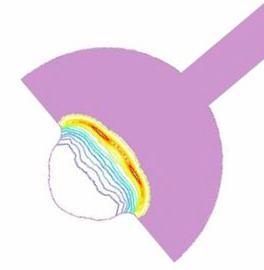Technology advancements over the last 50 years have made the laser one of the most effective means for depositing modest amounts of energy in very tight volumes and delivered in extremely short times. Because of this, high energy and ultraintense lasers have become important tools for creating and investigating systems in extreme states.
High energy lasers can drive shock waves into solids that propagate faster than 100 km/s and can compress matter to nearly 100 times the density of lead. At ultrahigh intensity (>1018 W/cm2) lasers efficiently couple energy to a critical density target, resulting in a hot plasma and, in some cases, high energy collimated beams of electrons and ions. These beams are appealing to many applications because of their ultrashort duration, small source size, and compact size as compared to acceleratory facilities. Such beams have been used for ultrafast radiography and deflectometry. They are also useful for heating a high density material to keV temperatures more rapidly than it can respond (isochoric heating).
The HEDP group performs advanced computer simulations and experiments at cutting edge laser facilities around the country to study interactions of ultraintense lasers with solid and warm dense targets. Most experiments relate to making beams which have appropriate parameters to ignite FI. Some of the issues being investigated include: Physics of laser/plasma interactions, Improving laser-to-beam energy efficiency via target design, Particle transport in warm dense matter, Beam/plasma instabilities, & Energy deposition in dense matter.
Fast Ignition
Fast Ignition is a special approach to Inertial Confinement Fusion (ICF) in which the energy to heat the fuel come from a separate laser, rather than from the implosion process. This allows for the fuel to be heated more efficiently. It is quite inefficient to heat fuel by the process of implosion.
There are a number of approaches to Fast Ignition that are under current study. The one that we are primarily involved in investigating is that known as ‘Re-entrant cone guided fast ignition’. In this approach a small gold cone is imbedded into the side of the spherical fuel capsule, providing a clear pathway to the central region where the compressed fuel globule is formed.
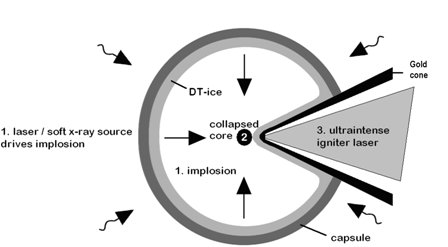
The ultraintense laser that ignites the fuel is fired into
the cone. Where it interacts with the cone tip an enormous
number of extremely energetic electrons are generated. These
electrons fly out into the fuel, heating it to the
temperatures required for fusion.
Re-entrant Cone Guided Fast Ignition is a 3 step process.
The implosion is driven by soft x-ray or laser radiation
(1) A dense fuel globule is formed at the tip of the cone
(2) Finally an ultraintense igniter laser injects energetic
electrons into the fuel, heating it to the conditions
required for fusion (3)
Inertial Confinement Fusion (ICF)
Inertial Confinement Fusion (ICF) is one of two major routes to releasing energy by the process of nuclear fusion for energy generation purposes. Nuclear fusion is the process that provides energy for stars in which two light nuclei join (or fuse) together. The initial mass of the two particles which fuse together is greater than the mass of the product. This small difference in mass is converted into energy in accordance with Einstein’s famous relationship E=mc2 and is eventually released to the surroundings, where it can be captured to generate electricity.
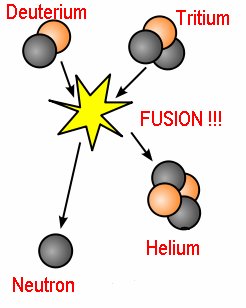 For nuclear fusion to occur the nuclei that make up the fuel
(Deuterium and Tritium) must be thrown together vigorously. This
is the same as saying that the fuel must be hot. When a gas is
hot, the individual particles that make up the gas fly about
more rapidly – and so collide more vigorously. The temperatures
required for fusion are such that the gas we are dealing with is
no longer composed of neutral atoms, but of charged ions and
electrons. Such a gas is called a plasma– sometimes called the
‘Fourth State of Matter.’
For nuclear fusion to occur the nuclei that make up the fuel
(Deuterium and Tritium) must be thrown together vigorously. This
is the same as saying that the fuel must be hot. When a gas is
hot, the individual particles that make up the gas fly about
more rapidly – and so collide more vigorously. The temperatures
required for fusion are such that the gas we are dealing with is
no longer composed of neutral atoms, but of charged ions and
electrons. Such a gas is called a plasma– sometimes called the
‘Fourth State of Matter.’
The reason why the particles must collide vigorously in order to fuse is that nuclei have positive charges. Like charges (e.g. two positive charges) repel one another due to the Electromagnetic Force. It is only the presence of the Strong Nuclear Force that permits the nuclei to stick together. However the attraction of the Strong Nuclear Force only operates at extremely short range. Throwing the nuclei together vigorously allows the nuclei to get close enough together that the Strong Nuclear Force can make them stick.
Another factor that affects fusion is the density of the material. This can be understood by considering that whilst the temperature determines how vigorously the particles collide, the density plays an important role in determining how often the particles collide. The higher the density of the fuel, therefore, the more rapidly fusion reactions will take place, and the more energy will be released in a given period of time.
In ICF, conditions of extremely high temperature and density are achieved by imploding a spherical capsule containing fusion fuel. This implosion is driven by laser radiation or soft x-rays. An implosion is basically the reverse of an explosion. In ICF we start off with a spherical shell that is a couple of millimeters in diameter, and make it implode upon itself until it is only a hundred microns or so across. The mechanism by which this is achieved is rather like the process that propels rockets into space. The outside of the capsule is made to expand rapidly outwards – much like a rocket exhaust. Then, by Newton’s third law, which states that “for each action there is an equal and opposite reaction”, the rest of the capsule implodes inwards. The expansion of the capsule surface is caused by intense heating with laser radiation or x-rays.
 The fuel is compressed to densities around 1000 times the
original solid density of the fuel, and its temperature is
raised to around 30,000,000 Celsius. In these conditions the
fuel starts to fuse, and release energy, which makes it get
even hotter. In a few tens of trillionths of a second the
fuel self heats to over a billion Celsius, releasing as much
energy as is stored in a stick of dynamite. This energy can
then be captured in the reactor vessel and converted into
electricity.
The fuel is compressed to densities around 1000 times the
original solid density of the fuel, and its temperature is
raised to around 30,000,000 Celsius. In these conditions the
fuel starts to fuse, and release energy, which makes it get
even hotter. In a few tens of trillionths of a second the
fuel self heats to over a billion Celsius, releasing as much
energy as is stored in a stick of dynamite. This energy can
then be captured in the reactor vessel and converted into
electricity.
ICF has not yet been demonstrated in the laboratory. The National Ignition Facility will aim to achieve the first demonstration of this approach to energy generation in around 2010. However there is a long way to go. The National Ignition Facility only aims to demonstrate the process of energy release – it will not be a power station since there will be no way to harness the energy released when the fuel is burnt. Also the laser which drives the implosion process can only be fired once every few hours. Not nearly often enough to release the quantities of energy required to make it a useful backbone for an electrical generator. That requires a laser that fires at a high repetition rate (e.g. once a second or more.) The National Ignition Facility represents only the first step along the road to power production: commercial electricity generation by ICF is not envisaged until around the middle of the 21st century!
PIC Modeling
Z-dependence on fast electron generation and transport relevant
to cone guided fast ignition
Recent advances in the development of intense short pulse lasers
have led to exciting progress in high energy density (HED) physics.
The interaction of relativistically intense (> 1018 W/cm2), short
(less than pico-second) laser pulses with solid generates supra-thermal
electrons (hundreds of keV to tens of MeV) at the target surface and
are important for various potential applications.
These include isochoric heating of dense plasma, generation of high energy electrons, production of hard and soft x-ray sources, and fast ignition of compressed fusion targets in laser fusion schemes. Particularly, in cone guided fast ignition scheme of inertial confinement fusion the energy coupling from laser to the compressed core strongly depends on laser produced fast electron beam divergence and their transport. The transport of these ultrafast electrons in a resistive material is an interesting study problem and better understanding is crucial towards the applications.
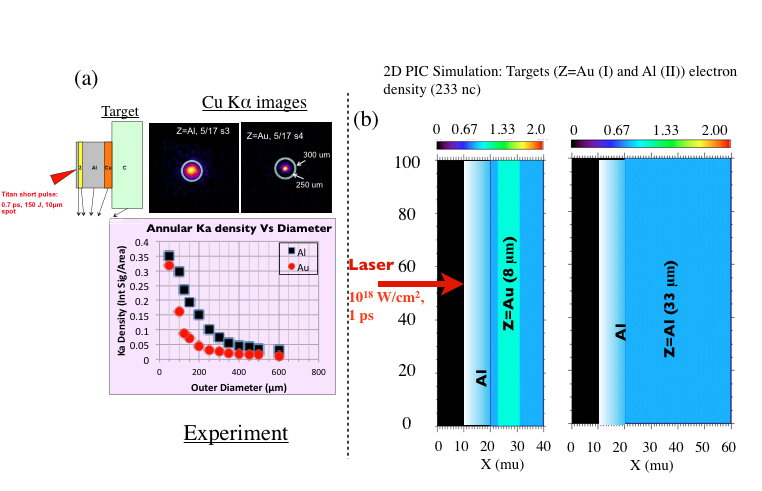 Figure 1(a): In Experiment a layered target
(Al + Z + Al + Cu) shot by Titan Laser. Smaller Cu Ka signal
observed in Z=Au. (b) Initial electron density setup in 2D
PIC simulation to model Z= Al (33 mu) and Z=Au (8 mu) target.
Figure 1(a): In Experiment a layered target
(Al + Z + Al + Cu) shot by Titan Laser. Smaller Cu Ka signal
observed in Z=Au. (b) Initial electron density setup in 2D
PIC simulation to model Z= Al (33 mu) and Z=Au (8 mu) target.
Fig. 1(b) shows a simulation setup to model the
experiment, see Fig 1(a), to investigate the resistive
effects of a transporting medium on a given fast electrons
source. 2D Collisional Particle-in-Cell (PIC) simulations
show that a thin high-Z transport layer (e.g., Au) near
lower Z source introduces a collimating effect on fast
electron transport. Strong self-generated resistive B-fields
are produced inside Au layer and at the interface (Al/Au),
which confine the fast electron propagation and can also
trap some electrons to inhibit their propagation.
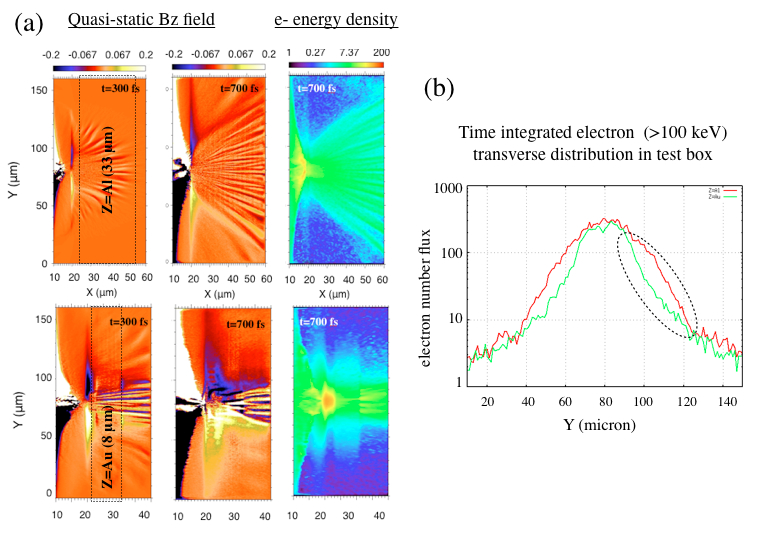 Figure 2(a): Quasi-static azimuthal B-fields of the
order of 100 MG produced in Au collimate fast electrons.
Electron energy density plots show confined electron
propagation through Z=Au layer.
Figure 2(a): Quasi-static azimuthal B-fields of the
order of 100 MG produced in Au collimate fast electrons.
Electron energy density plots show confined electron
propagation through Z=Au layer.
Figure 2(b): Time integrated
electron flux after Z layers show comparable yields at
the center and reduced electron density on the wings,
consistent with experimental observation of integrated
photon density.
This collimating effect can be extremely helpful to suppress the otherwise divergent fast electron beam and consequently reduce the requirement of ignition energy. Several experimental and simulation studies are being dedicated to further explore the Z-dependence for larger time scale (> picosecond) and conical geometry relevant to cone guided fast ignition.
Integrated point design simulation for proton fast ignition
For the proton fast ignition concept, there is a need for a proton
source focusing design, which includes the walls of the cone and
the transmission through the cone tip to the fuel.
The effects of proton energy loss in the cone tip, scattering and spot enlargement as well as the influence of electron interaction with the cone, guiding and instabilities have to been addressed. To understanding these physics, the integrated point-design simulations by the hybrid PIC code, large-scale plasma (LSP), are carried out.
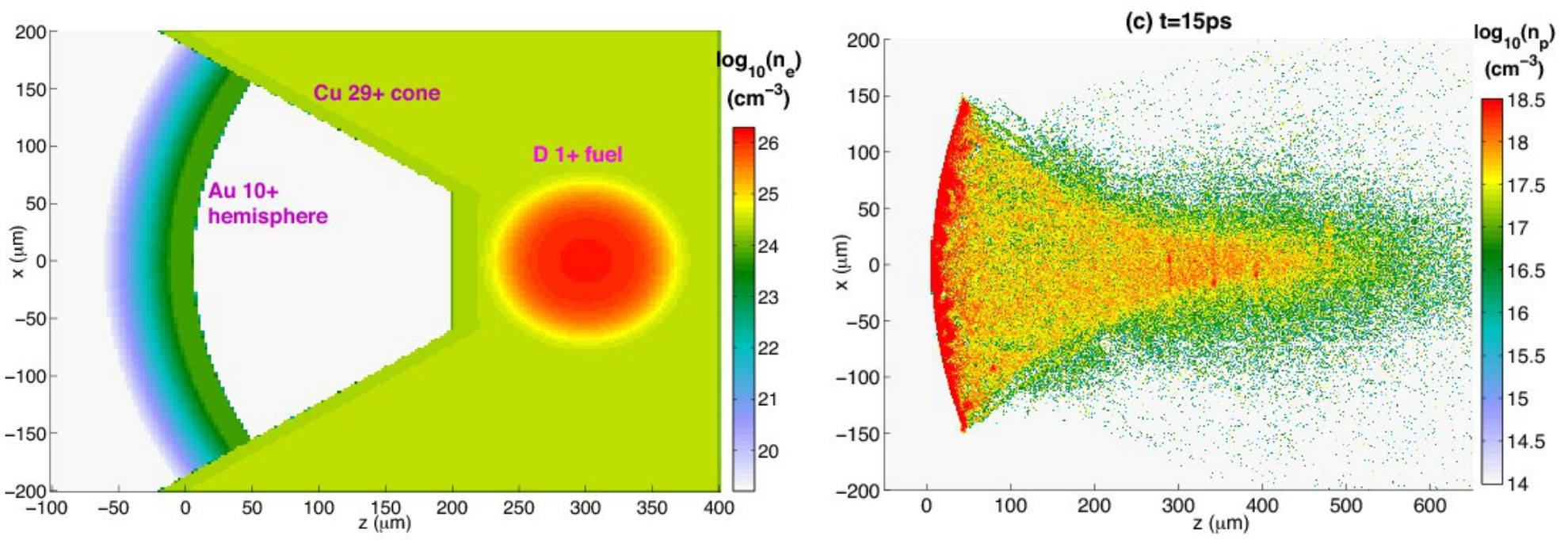
Left: integrated LSP simulation set-up for point-design
of proton fast ignition (FI).
Right: proton source density
at time t=15ps from the FI-related hemisphere-cone target
(without cone tip and fuel) obtained by LSP simulation.
Fundamental physics of proton beam interactions with ionized plasma
The fundamental issues surrounding the propagation and interactions
of a laser accelerated beam through a plasma, and will lead to a
better understanding in general of proton beam interactions for many
applications including laser-based high-energy accelerators, warm
dense matter creation, astrophysics, and high-intensity high-energy
particle beam propagation in the atmosphere and outer-space
plasmas, etc.
The new physical questions include: how will beam focusing be altered upon entering a plasma? What effects limit transport of a charge-neutralized proton beam in plasma? How effectively can protons deposit energy in solid targets and warm dense matter?
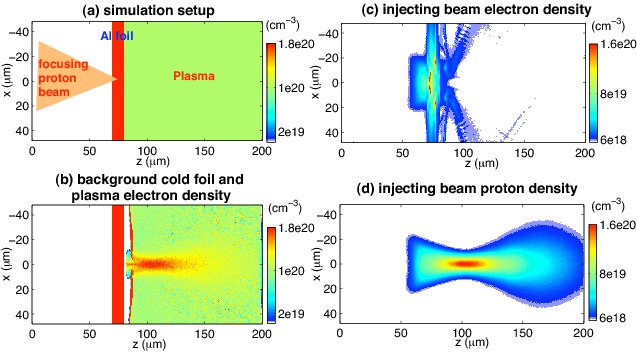
Figure: LSP preliminary simulation result shows clearly the energy exchange between the hot co-moving beam electrons and the background plasma electrons and enhanced focusing of the proton beam when the proton beam transitions between vacuum and plasma
Proton beam transport and energy deposition in solid-density matter
Laser accelerated protons have high energy (>MeV) in strong current
beams (10s of kA) that can be focused to 10s of µm, resulting in
sufficiently high intensity to achieve isochoric heating. These
intense proton beam transport and energy deposition in solid-density
matter can be studied through self-consistent hybrid
particle-in-cell (PIC) simulations.

The figure shows the final heated target (ion) temperature maps, Ti in LSP simulations, for proton beam with fixed beam current density 1010 A/cm2, monoenergetic energies (5 MeV) and flat top durations (3ps). Here, three categories of simulations were carried out by (a) switching off both the stopping power updating and the field updating modules, (b) switching the stopping power updating module on but the field updating module off, and (c) switching on both self-consistent calculation modules. For case (a), the heated target region is highly localized at the end of proton projected depth, 175µm. For case (b), the stopping power decreases and the Bragg peak is flattened. Therefore, the beam experiences a dynamic and delocalized energy deposition. For case (c), the narrow beam in field effects, the heated region is confined to the central axis. The maximum temperature (~350 eV) is more than 3 times that of the wide case despite having the same current densities. This demonstrates that the collective interaction effect plays an important role in beam transport and energy deposition.
Laser Plasma Experiments
Proton Radiography
Proton radiography and deflectometry are important tools for
studying High Energy Density plasmas such as those encountered for
Inertial Confinement Fusion (ICF) Fast Ignition.
An application of proton radiography is described below. A high intensity laser interacts with a cone-wire target, heating the wire and generating strong electric and magnetic fields. A second high intensity laser irradiates a metal foil generating a beam of protons which backlights the wire.
Because the backlighter beam contains protons with a wide range of velocity, the interaction is probed at a range of times. Protons of differing energy are detected on different slices of a film stack. In the figure below, two radiographs from a single shot are shown. The high energy protons probe the interaction early (left) while lower energy protons (right) probe later and are more susceptible to deflection by fields. This diagnostic can therefore be used to detect electric and magnetic fields with ultrafast time resolution.

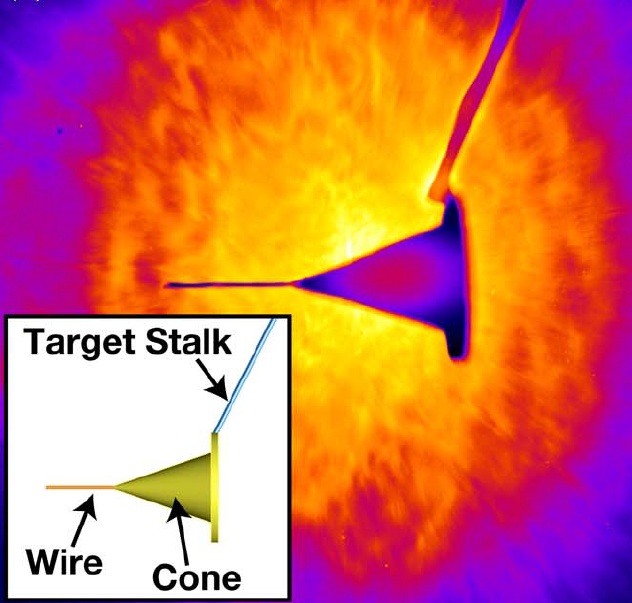
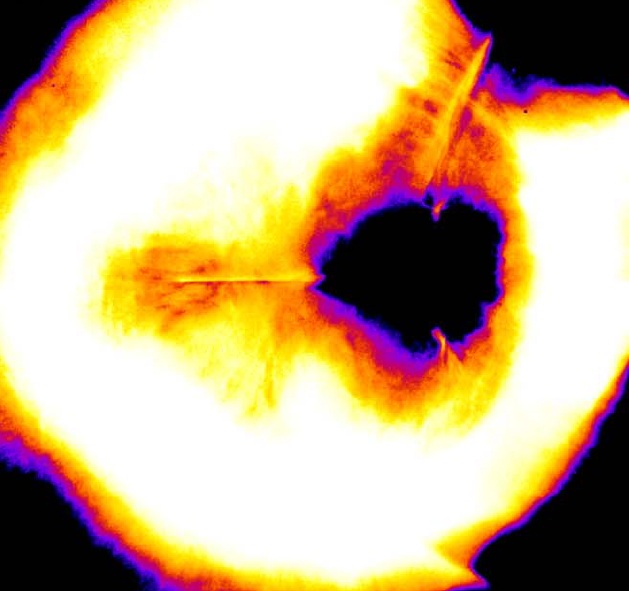
Electron Transport
Electron beam transport in warm dense matter is a crucial step in
heating of fuel in Fast Ignition. Beam spreading, deposition, and
filamentation are important effects that determine the efficiency
and gain of Fast Ignition inertial fusion energy.
To study these transport issues, electrons are generated by a high intensity laser interaction with solid foil. A thin copper foil is placed in the electron beam path. An image of the copper K-alpha emission shows a slice of the region heated by the beam. By varying laser prepulse conditions and depth of the copper foil, the electron beam transport and deposition can be studied.
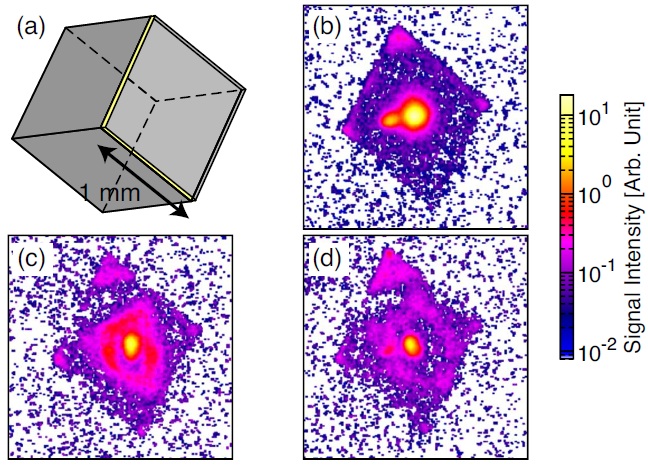
Proton Focusing
The energy for Fast Ignition of nuclear fusion may be delivered to
dense fuel by an ultrashort burst of electrons or protons from a
high intensity laser interaction. One potential advantage of using
protons is that they can be generated as a focusing beam by using a
curved shell target.
This is important because ignition requires the proton beam to deposit energy in a tight enough volume that the local heating exceeds radiation losses. Experiments have been conducted to diagnose the proton beam focal position and focused diameter. As shown in the figure below, when a focusing beam is sent through metal meshes and used to expose a film stack, the imprinted mesh shadow can be used to calculate proton trajectories. Recent experiments using this method have demonstrated that a curved foil can focus a proton beam to as small as a few 10s of microns- fulfilling one of the requirements for Fast Ignition.

Low mass target experiments
In these experiments we expose targets that have a mass of only a
few milligrams to intense pulses of laser light. Concentrating the
energy of a high power short pulse laser into such a small quantity
of material results in extremely high temperatures
(around 10 million Kelvin).
The purpose of these experiments is to investigate the physics of the Fast Ignition approach to Inertial Confinement Fusion (ICF) and also to study the processes involved in creating ultra-bright laser driven x-ray sources. Such sources may be used to probe extremely fast moving phenomena since the effective duration of the flash is only a few picoseconds in duration.
Figure: Radiation emitted from a low mass nail target
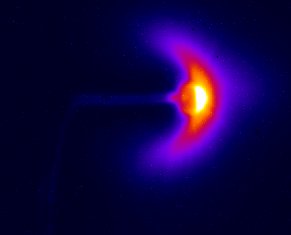
Warm dense matter transport experiments
The transport of laser generated relativistic electrons in materials
with temperatures of approximately one million Kelvin, and densities
of 1g/cc or higher, is of considerable importance to Fast Ignition.
Such experiments require both high energy nanosecond and picosecond duration beams, to, respectively, form the warm dense matter, and drive the relativistic electron beam. There are only a handful of facilities with such capabilities in the world. We perform our experiments at the Titan Laser at the Lawrence Livermore National Laboratory in Northern California.
Figure: Radiation emitted by a warm dense matter target
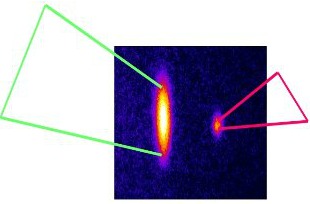
2-D radiation hydrodynamics simulations
In considering the behavior of materials at high temperatures, it is
often important to consider the effects of the radiation that is
emitted by the material upon the dynamics of the physical system.
Radiation can couple energy between spatially separated regions and allow for fluid to be accelerated, heated and compressed without mechanical intervention. In order to assist us in the design and analysis of experiments, in which targets often exceed temperatures of a million Kelvin, we employ sophisticated two-dimensional radiation hydrodynamics modeling using the code h2d. This code is hosted at General Atomics.
Figure: Radiation emitted by a warm dense matter target
